
Maryborough Courthouse is a heritage-listed courthouse at 170 Richmond Street, Maryborough, Fraser Coast Region, Queensland, Australia. It was designed by Francis Drummond Greville Stanley and built in 1877 by John Thomas Annear for the Queensland Government. It is also known as Maryborough Court House and Government Offices. It was added to the Queensland Heritage Register on 21 October 1992.
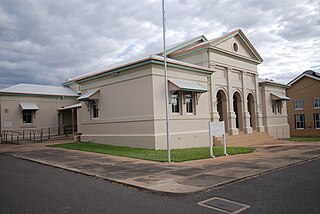
Charters Towers Courthouse is a heritage-listed courthouse at 28 Hodgkinson Street, Charters Towers City, Charters Towers, Charters Towers Region, Queensland, Australia. It was designed by John James Clark and built in 1886 by Charles Miller. It is also known as Charters Towers Courthouse. It was added to the Queensland Heritage Register on 21 October 1992.
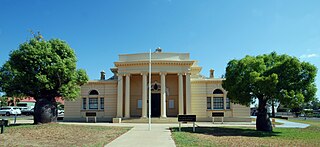
Roma Courthouse is a heritage-listed courthouse at 141 McDowall Street, Roma, Maranoa Region, Queensland, Australia. Constructed in 1901, the courthouse is a rendered masonry building, which is still in use today. Predominately influenced by the Federation free style, it is considered a stunning example of Federation colonial architecture at its best. It is also known as Roma Court House and Roma Police Buildings. It was added to the Queensland Heritage Register on 7 August 1998.

Bowen Courthouse is a heritage-listed courthouse at 30 Williams Street, Bowen, Whitsunday Region, Queensland, Australia. It was designed by George St Paul Connolly of the Colonial Architect's Office and built in 1880 by Southall & Tracey. It is also known as Bowen Court House. It was added to the Queensland Heritage Register on 21 October 1992.

Rosewood Courthouse is a heritage-listed courthouse at 1 John Street, Rosewood, City of Ipswich, Queensland, Australia. It was built from 1908 to 1923. It is also known as Rosewood police residence. It was added to the Queensland Heritage Register on 6 June 1994.

Gympie Lands Office is a heritage-listed former court house and public administration building at 26 Channon Street, Gympie, Queensland, Australia. It was designed by Queensland Department of Public Works and Queensland Colonial Architect's Office and built in 1942 by the Department of Public Works, Gympie City Council, Mark Doggett, Andrew Collins, and George Caldwell. It was added to the Queensland Heritage Register on 15 July 2011.

Rockhampton Courthouse is a heritage-listed courthouse at 42 East Street, Rockhampton, Rockhampton Region, Queensland, Australia. It was designed by John Hitch and built from 1950 to 1955. It is also known as District Court, Queensland Government Savings Bank, Commonwealth Bank, Magistrate's Court, Police Court, and Supreme Court. It was added to the Queensland Heritage Register on 21 October 1992.

Maryborough Government Offices Building is a heritage-listed office building at 123 Wharf Street, Maryborough, Fraser Coast Region, Queensland, Australia. It was designed by Gilbert Robert Beveridge and Raymond Clare Nowland and built in 1940 by relief work. It is also known as State Government Insurance Offices and State Government Offices. It was added to the Queensland Heritage Register on 21 October 1992.

Childers Court House is a heritage-listed courthouse at Churchill Street, Childers, Bundaberg Region, Queensland, Australia. It was designed by Queensland Colonial Architect's Office and built in 1897 by William Cristine Horton and Louis Bouttell. It was added to the Queensland Heritage Register on 21 October 1992.
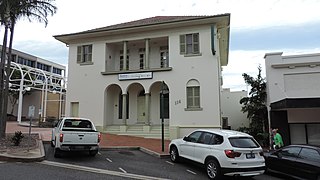
Commonwealth Bank Building is a heritage-listed former bank building at 114 Goondoon Street, Gladstone Central, Gladstone, Gladstone Region, Queensland, Australia. It was built from 1928 to 1929. It was added to the Queensland Heritage Register on 28 July 2000.

Gladstone Post Office is a heritage-listed former post office at 33 Goondoon Street, Gladstone, Gladstone Region, Queensland, Australia. It was built in 1932 by relief workers. It was added to the Queensland Heritage Register on 7 May 1998.
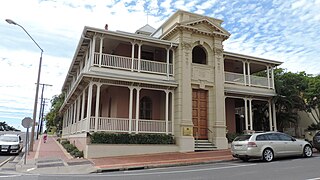
Kullaroo House is a heritage-listed former bank building at 40 Goondoon Street, Gladstone, Gladstone Region, Queensland, Australia. It was designed by James Percy Owen Cowlishaw and built from 1910 to 1911 by A A Carrick. It is also known as Commercial Banking Company of Sydney Ltd. It was added to the Queensland Heritage Register on 5 March 1999.

Mount Morgan Court House and Police Station is a heritage-listed courthouse and police station at 28 Hall Street, Mount Morgan, Rockhampton Region, Queensland, Australia. It was designed by Queensland Department of Public Works and built from 1898 to 1900 by John Macfarlane and Co. It was added to the Queensland Heritage Register on 21 October 1992.
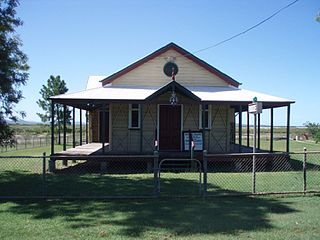
St Lawrence Police Station is a heritage-listed police station and former courthouse at Macartney Street, St Lawrence, Isaac Region, Queensland, Australia. It was built from 1878 to 1934. It is also known as former St Lawrence Courthouse and Cell Block. It was added to the Queensland Heritage Register on 24 November 2000.

Mackay Court House and Police Station is a heritage-listed courthouse and police station at 67 Victoria Street and 14 Brisbane Street, Mackay, Mackay Region, Queensland, Australia. They were built from 1886 to 1963. It is also known as Mackay Court House and Mackay Police Station. It was added to the Queensland Heritage Register on 21 October 1992.
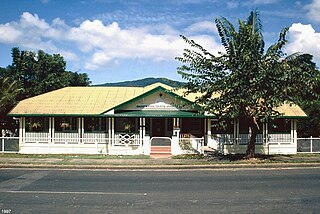
Tully Court House is a heritage-listed courthouse at 46 Bryant Street, Tully, Cassowary Coast Region, Queensland, Australia. It was designed by Nigel Laman Thomas of the Department of Public Works (Queensland) and built from 1941 to 1945. It was added to the Queensland Heritage Register on 24 September 1999.

The Second Innisfail Court House is a heritage-listed former court house and police station in Innisfail, Cassowary Coast Region, Queensland, Australia, which was subsequently relocated and used as a private residence at 40 Buckley Street, Yorkeys Knob, Cairns Region, Queensland, Australia. It was designed by Department of Public Works (Queensland) and built from 1920 to 1930s. It is also known as the former Innisfail Police Station. It was added to the Queensland Heritage Register on 6 December 2004.

Cairns Court House Complex is a heritage-listed site incorporating a former courthouse and a former public administration building at 38–40 Abbott Street, Cairns City, Cairns, Cairns Region, Queensland, Australia. It was built from 1919 to 1921. It was added to the Queensland Heritage Register on 21 October 1992.

Croydon Court House is a heritage-listed former courthouse at Samwell Street, Croydon, Shire of Croydon, Queensland, Australia. It was designed by Colonial Architect's Office and built in 1887. It was added to the Queensland Heritage Register on 21 October 1992.

Tambo Court House is a heritage-listed former courthouse and now library at 9 Arthur Street, Tambo, Blackall-Tambo Region, Queensland, Australia. It was built from 1887 to 1897. It is also known as Tambo Shire Council Library. It was added to the Queensland Heritage Register on 21 October 1992.























